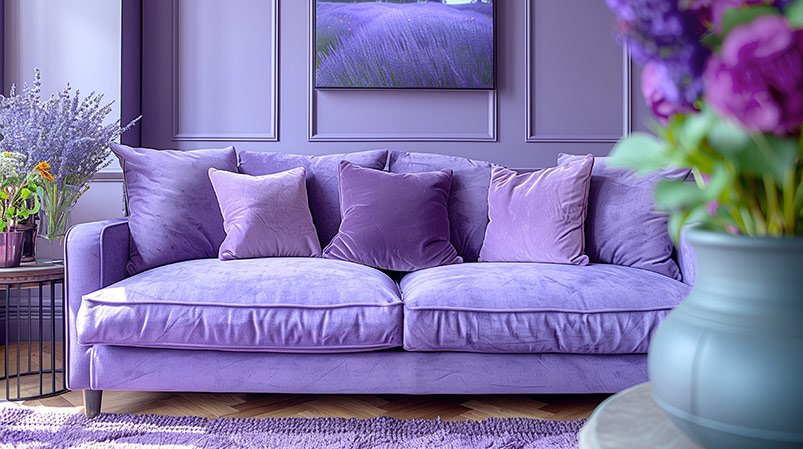Blog
How to clean couch cushion?

Introduction
Imagine it’s the end of a busy day, and you finally get to relax on your favorite couch. The soft cushions cradle you in comfort, offering a sanctuary of peace. however, maybe you see a few unwelcome guests – stains, crumbs, and an odd, musty smell.
At Venus Home Furniture, we understand that your couch is more than just a piece of furniture; it’s a hub of family gatherings and the main focal point of your house. Keeping it clean not only maintains its beauty but also guarantees a healthy living environment.
Why Do I Need to Wash My Sofa Cushions?
Of course, it has many advantages and in this article, we’re going to cover them.
Health Benefits:
Regularly washing your sofa cushions can efficiently reduce allergens such as dust mites, pet dander, and pollen. These tiny particles can trigger allergies and asthma. If you want to create a healthier space for everyone, you have to keep your cushions clean.
Benefits to appearance: In regular use of your couch, cushions can find stains and discoloration over time. Spilled coffee, food crumbs, and even the natural oils from our skin can leave unsightly marks. Regular cleaning helps maintain the vibrant look of your cushions, keeping your living room looking fresh and inviting.
Longevity: Regular care for your sofa cushions would extend their lifetime like you would do so with a car or a laptop. Dirt and grime can wear down the fabric and stuffing, leading to a lumpy, and uncomfortable seating experience. Clean cushions not only look better but also feel better, providing the support and comfort you expect.
It’s good to ask yourself:
- Have you noticed any health changes in your family that might be due to home allergens?
- Do your cushions still look and feel like new?
By asking these questions, you can better understand the importance of regular cleaning.

Check the Cushion Material
Several materials are used to make sofa cushions, and each one needs a different cleaning method.
Finding the Material Information:
Look for tags on your cushions or consult the manufacturer’s website. These tags usually provide essential details about the fabric type and care instructions. If you’re not sure about the material, you can search on the internet or call the manufacturer to get your information.
Common Types of Materials and Their Needs:
- Fabric: One of the most common materials is fabric. Fabric cushions are usually made of cotton, polyester, or a blend of both. They are usually washed easily and via spot cleaning and gentle machine washing.
- Leather: Leather cushions show luxury and are relatively easy to clean if you find the right products. But you need to avoid soaking them in water and use leather-specific cleaners.
- Microfiber: Known for its stain resistance, microfiber is a popular choice for busy households. It’s easy to clean with mild soap and water.
- Velvet: Handling velvet cushions with care is necessary. They should be cleaned with a soft brush and mild detergent to maintain their plush texture. Velvet cushions are like the fancy outfits in your wardrobe but only for your sofa set – they need gentle care to stay beautiful.
It’s good to ask yourself:
- Why is knowing your cushion material before cleaning is so much important?
- What is going to happen if you clean your cushions using the wrong methods?
Understanding your cushion material is the first step towards effective cleaning.
Check the Cleaning Codes:
After determining the material of your sofa cushions, it’s time to figure out how to clean them. These codes will guide you to the ideal cleaning methods for your particular cushions, much like a secret map.
Finding the Cleaning Codes:
The cleaning codes are typically found on the care tags attached to your cushions. These tags often use a combination of letters to indicate the recommended cleaning methods. If you can’t find the tag, refer to the manufacturer’s guidelines or website.
Recognizing the Codes:
- W – Water-Based Cleaner: Cleaning solutions based on the water can be used to clean cushions with a “W” classification. This makes them relatively easy to clean at home with common household products.
- S – Solvent-Based Cleaner: Solvent-based cleaners, such as those used for dry cleaning, are necessary for cushions with a “S” on the label. These are generally used for materials that may be damaged by water.
- WS – Water or Solvent-Based Cleaner: Cushions with a “WS” code can be cleaned with either water-based or solvent-based cleaners. This diversity allows you to choose the method that suits your needs best.
- X- Vacuum Only: Cushions marked “X” should only be vacuumed. Water and chemicals may harm these materials, so vacuuming is the best way to keep them clean.
Understanding the cleaning codes can help you maintain your sofa cushions successfully.

How to Clean Sofa Cushion Covers Properly
Once you’ve figured out the cleaning codes and recognized the material, it’s time to get to work and do some cleanings. Cleaning your sofa cushion covers properly can make a significant difference in their appearance and lifetime.
Step-by-Step Guide for Cleaning Cushion Covers:
- Preparation: Check the Tag: Ensure that you have read the cleaning instructions on the tag.Pre-Treat Stains: Use a gentle stain remover that is suitable for your cushion material. Apply it to stains and let it rest for a few minutes.
- Cleaning: Water-based cleaning (W or WS): Combine a mild detergent with water. Soak a clean cloth in the solution and gently wipe the spots. Do not wet the cloth.
Solvent-Based Cleaning (S or WS): Apply a dry-cleaning solvent to a clean cloth and blot the stains. Be sure to work in a well-ventilated area.
Machine Washing: If the tag allows, remove the covers and wash them in the machine on a gentle cycle with mild detergent. Always use cold water to prevent shrinking. Washing cushion covers must be gentle handled to preserve their integrity.
- Drying: Air Dry: To avoid shrinkage, cushion coverings should always be air dried. Place them flat on a clean, dry towel or hang them in a well-ventilated place.
Avoid Direct Sunlight: To prevent fading, dry them in a dark place. To keep the form and color of cushion coverings, avoid heat and direct sunlight when drying them.
Consider :
- Are there specific stains that need special treatment?
- Do your cushion covers have any decorations or delicate details that require extra care?
How to Deep-Clean Non-Removable Couch Cushions
Non-removable cushions might be more difficult to clean, but with the appropriate method, you can still get great results.
Step-by-Step Guide to Deep-Cleaning Non-Removable Cushions:
Preparation:
- Vacuum thoroughly: Begin by vacuuming the cushions to remove any loose dirt and particles.
- Spot Cleaning: Treat any visible stains with a suitable upholstery cleaner.
Surface Cleaning:
- Mild Detergent Solution: Mix a small amount of mild detergent with water. Soak a clean cloth with the solution and gently blot the cushions. Avoid soaking the fabric and clean gently to avoid damage.
Steam Cleaning:
- Use a Steam Cleaner: If the cushion’s material can handle moisture, use a steam cleaner to deep-clean the fabric. The steam helps to sanitize and refresh the cushions. Steam cleaning cushions will revitalize the fabric and remove embedded dirt.
Drying:
- Air Dry: Allow the cushions to air dry completely. Use fans or open windows to speed up the drying process and prevent mold growth.
Consider this :
- What are the best tools and products for deep-cleaning your specific cushion material?
- How can you ensure complete drying to prevent mold and mildew?

Health and Safety Concerns
Finally, let’s discuss health and safety considerations to ensure that your cleaning procedure is both effective and safe. Cleaning your sofa cushions is about more than simply beauty; it’s also about maintaining a healthy living environment.
- Allergen Reduction: Regular cleaning of your cushions helps to minimize allergies like as dust mites, pet dander, and pollen. This is especially crucial for families with allergy problems. Keep in mind that a thorough cleaning may dramatically improve air quality and relieve allergy problems.
- Avoiding Harsh Chemicals: Mild Detergents: Use gentle, non-toxic cleaning chemicals to prevent skin irritation and asthma.
Proper Ventilation: Make sure your cleaning space is well-ventilated to avoid fumes from cleaning chemicals. Using mild cleansers is beneficial for both you and the environment.
- Preventing Mold and Mildew: Complete Drying: To avoid mold and mildew formation, cushions should always be totally dried before reuse. Drying needs attention to detail and patience.
important :
- Are you using safe and effective cleaning products?
- How can you increase airflow in your cleaning area to guarantee safety?
Conclusion
Maintaining clean and fresh sofa cushions is critical not just for the appearance of your house, but also for your family’s health and comfort. From knowing why it’s vital to clean your cushions to verifying the material and cleaning codes and learning both surface and deep-cleaning procedures, you now have a thorough guide to keeping your furniture in good condition.
Regular maintenance, spot cleaning, and occasional deep cleaning can extend the life of your cushions, making your living space more inviting and comfortable. Remember, a clean couch is not just about looks; it’s about creating a healthier environment for everyone in your household.
So, the next time you notice a stain or feel your cushions are losing their freshness or maybe smell an unpleasant smell, you’ll know exactly what to do. By following these tips and incorporating regular cleaning into your routine, you’ll ensure your sofa remains a cozy haven for years to come.

FAQs
-
How often should I clean my couch cushions?
It’s recommended to clean your couch cushions at least once every three months. Spot clean stains as soon as they occur to prevent them from setting. For homes with pets or children, more frequent cleaning might be necessary.
-
Can I use a steam cleaner on my couch cushions?
Yes, you can use a steam cleaner on most couch cushions, but always check the manufacturer’s cleaning codes first. Steam cleaning is particularly effective for deep cleaning and sanitizing fabric.
-
What do the cleaning codes on my couch cushions mean?
Cleaning codes indicate the safest cleaning methods for your cushions:
W: Water-based cleaners
S: Solvent-based cleaners
WS: Water or solvent-based cleaners
X: Vacuum or dry brush only
-
How can I remove pet hair from my couch cushions?
Use a vacuum with an upholstery attachment, a lint roller, or a rubber glove (dampened with water) to remove pet hair. Regular vacuuming helps prevent hair buildup.
-
What’s the best way to remove stains from my couch cushions?
Blot the stain immediately with a clean cloth. Use a cleaning solution appropriate for your cushion’s material, following the cleaning code. Test the solution on a hidden area first.
-
Can I wash couch cushion covers in the washing machine?
If the covers are detachable and the cleaning code is safe (typically W or WS), you can machine wash them. To reduce shrinking, wash on a gentle cycle with mild detergent and air dry.
-
How can I freshen up my couch cushions without washing them?
Sprinkle baking soda over the cushions, allow them to rest for 15-20 minutes, and then vacuum them. This helps eliminate smells. You may also apply a cloth refresher spray.
-
Is it safe to use bleach on my couch cushions?
Generally, it’s not recommended to use bleach on couch cushions as it can damage the fabric and discolor the material. Use a fabric-safe cleaner instead.
-
What should I do if my couch cushions start to smell musty?
First, vacuum the cushions thoroughly. Then, sprinkle baking soda over the cushions and let it sit for a few hours to absorb odors before vacuuming it off. If the smell persists, consider a deeper cleaning method, such as steam cleaning or using a fabric refresher spray.


